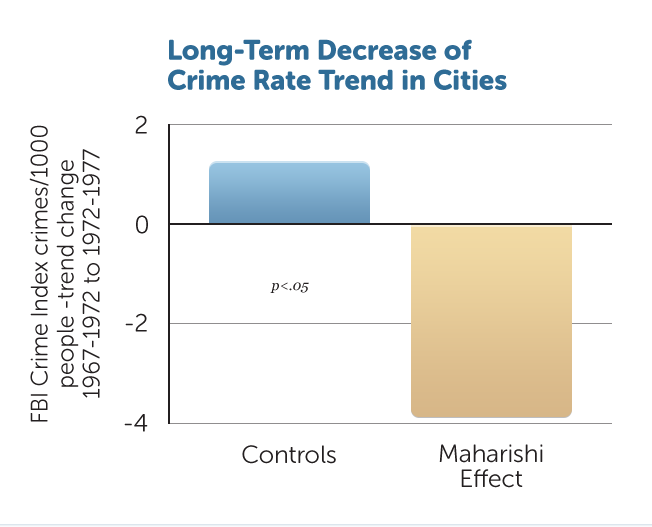Study 3: Crime decrease in 24 cities across the U.S.
This study is a follow up study from study 1, the earlier study where in 11 cities where 1% of the population had learned the TM technique a decrease in crime was noticed of 16.5% as compared to control cities. This study is an expansion of the original study in several areas: more cities (24 instead of 11), better monitoring of other possible variables that could explain the effect, and the effect seen over a longer time period (5 years instead of 1 year).
Other possible explanations for crime decrease were studied and ruled out in this study (because they were comparable to control cities). The control cities were also selected by an independent scientist, so that there could be no case of sub-conscious influencing of the result through the choosing of specific control cities.
- Average level of education
- Percentage in the same residential area after 5 years
- Unemployment rate
- Percentage in age group 15-29 years
- Percentage under poverty line
- Population density
- Per capita income.
 This more detailed study demonstrated that the effect that could be attributed to the TM practitioners was greater than in the earlier study (study 1). It was calculated that the TM practitioners had created a 22% decrease of crime (p<.001). In the longer term as well, over a period of 5 years, the control cities saw a faster increase in crime than predicted against earlier trends, while the 1% cities demonstrated a consistent decrease in crime as compared to earlier trends.Ref.Journal of Crime and Justice vol. 4, 1981, pp 25-45
This more detailed study demonstrated that the effect that could be attributed to the TM practitioners was greater than in the earlier study (study 1). It was calculated that the TM practitioners had created a 22% decrease of crime (p<.001). In the longer term as well, over a period of 5 years, the control cities saw a faster increase in crime than predicted against earlier trends, while the 1% cities demonstrated a consistent decrease in crime as compared to earlier trends.Ref.Journal of Crime and Justice vol. 4, 1981, pp 25-45
Miten yksinkertainen tekniikka voi saada aikaan niin paljon?
600 tutkimusta vahvistaa TM:n vaikutukset:
- Vähemmän stressiä
- Miten TM toimii
- Masennus
- Ahdistus
- Tunne-elämän vakaus
- Unettomuus
- Impulsiivisuus
- Traumanjälkeinen stressi
- Aivojen kehittyminen
- Miten TM toimii
- ADHD
- Älykkyys
- Luovuus
- Ole oma itsesi
- Menesty = ole oma itsesi
- Itsensä toteuttaminen
- Lisää itseluottamusta
- Paremmat ihmissuhteet
- Yhteiskunta
- Koulutus
- Vankilat
- Liike-elämä
- Parempi maailma

